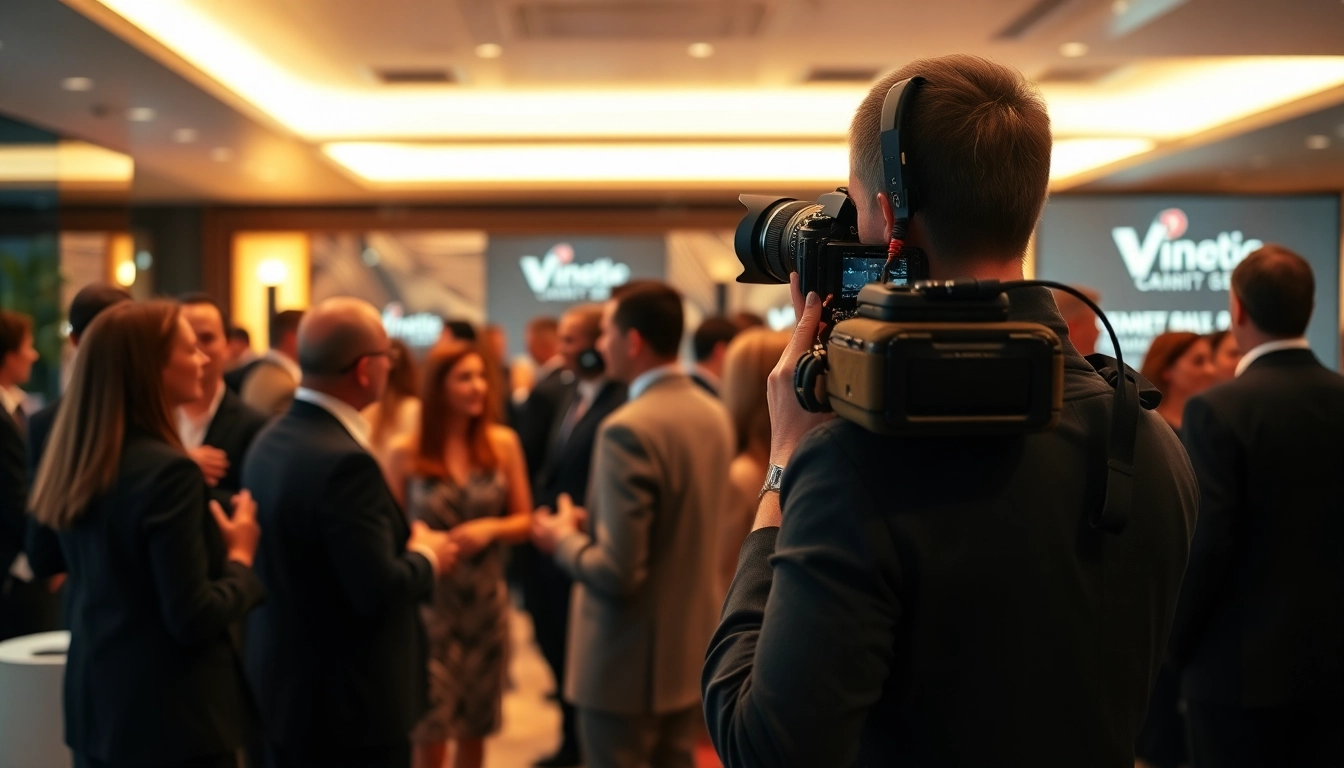Understanding Miami Corporate Event Videography Photography
In the bustling world of Miami’s corporate scene, the significance of capturing high-quality visuals during events cannot be overstated. The art of Miami Corporate Event Videography Photography goes beyond simply documenting an occasion; it involves creating lasting memories that can enhance brand reputation and engagement. Whether it’s a conference, product launch, or team-building event, effective videography and photography are crucial in conveying the essence of the moment and evoking the right emotions among the audience.
What is Corporate Event Videography?
Corporate event videography refers to the process of capturing video footage during corporate events. This not only documents the event but also tells a story that resonates with viewers, showcasing the atmosphere, interactions, and key moments in a visually compelling way. Companies use this footage for various purposes, including marketing campaigns, training materials, or simply to preserve the memories of significant events.
The role of a corporate event videographer is multifaceted. They must capture various angles, focus on critical interactions, and ensure every element of the event is represented in a way that aligns with the company’s branding and messaging. Additionally, the videographer often handles post-production work, which includes editing the footage into cohesive narratives that can be easily viewed and shared.
Importance of Photography in Corporate Events
While videography adds depth to the visual storytelling of an event, photography plays a significant role as well. High-quality photographs can encapsulate key moments in vivid detail, allowing companies to share visual updates on social media, websites, or internal communications. These images serve not just as memories, but as powerful tools for marketing and engagement.
Moreover, photographs can be more spontaneously shared than videos, making them essential for real-time social media engagement. Highlighting team activities, guest speakers, and participant interactions through appealing visuals can significantly boost a company’s online presence. Engaging your audience visually can lead to increased interest and attendance at future events.
Key Elements of Successful Event Coverage
Achieving effective event coverage entails several fundamental elements that must not be overlooked:
- Planning and Preparation: Strategically planning the videography and photography setup before the event ensures that the essentials are covered. This might include site visits, discussing the event itinerary, and understanding the desired outcomes.
- Capturing Key Moments: It is essential to pinpoint pivotal moments during the event—such as key speeches, award presentations, or networking sessions—to prioritize in both video and photographs.
- Post-Production Editing: The importance of post-production cannot be emphasized enough. High-quality editing can elevate the visual appeal and ensure the content aligns with the company’s branding.
Key Features of Professional Videography and Photography
High-Quality Equipment and Technology
The backbone of exceptional corporate event photography and videography lies in the quality of equipment used. Professional-grade cameras, lenses, audio devices, and lighting setups are essential to ensure the best imagery and sound quality. Cutting-edge technology enables professionals to adapt to varying light conditions and capture stunning visuals, regardless of the event’s setting.
Moreover, the latest editing software must be leveraged to produce sleek and polished final products. By utilizing the best technology, companies can assure their stakeholders and audience members that they are committed to excellence.
Skilled Workforce and Expertise
Not only is equipment crucial, but the expertise of the personnel operating it is equally important. A skilled workforce with both technical proficiency and a creative eye can make all the difference in producing compelling content. Videographers and photographers should thoroughly understand the narrative they aim to create, the emotions they want to evoke, and the images they want to convey. Furthermore, coordination between both teams is vital to ensure complementary content creation.
Effective Storytelling through Visuals
Great corporate event videography and photography tell a story. This narrative should align with the company’s branding and messaging. Using elements such as interviews, testimonials, and candid moments can enrich the story, showcasing not only the event itself but the company culture, values, and mission. Storytelling helps to create a connection with the audience, making them feel more involved and invested in the brand.
Tips for Selecting the Right Service Providers
Evaluating Portfolios and Reviews
Before selecting a corporate event videography and photography service provider, it is essential to review their portfolio. A diverse collection of work can provide insight into their style, creativity, and capability to handle various types of events. Alongside this, examining client reviews or testimonials can further validate the quality of their service.
Look for a provider that has experience in your industry and can demonstrate an understanding of your company’s unique style and objectives. Previous work that resonates with your company culture or brand message can be a significant indicator of future performance.
Understanding Pricing Structures
The cost of professional event photography and videography can vary widely depending on several factors, including the duration of the event, the complexity of the shoot, and the required deliverables. It’s crucial to understand the pricing structures to avoid surprises later on. Some providers may offer packages that include photography, videography, editing, and prints, while others may have a la carte options.
Ensure that you clarify what is included in the price. This might involve the number of hours on-site, the quantity of edited photos, or the length of the final video. Transparent pricing can facilitate smoother interactions and better outcomes.
Communicating Your Vision and Goals
Effective communication with your chosen videographer and photographer is essential for a successful outcome. Share your vision, expectations, and goals for the event. Detailed discussions can help the team understand the message you aim to communicate through the visuals.
Creating a shot list can be highly beneficial in this process. This document can outline key moments, guests, and specific activities that are central to the event’s narrative, ensuring that nothing critical is overlooked.
Best Practices for Event Planning with Videography in Mind
Incorporating Visuals into Event Marketing
Visual content is a powerful marketing tool that should be integrated into your event planning from the outset. Use high-quality imagery and video snippets in promotional materials to generate excitement and anticipation ahead of the event. Sharing behind-the-scenes footage during the planning phases can engage your audience and provide them with a sneak peek of what to expect.
Post-event, consider using professionally edited video highlights and photos to share the experience on marketing platforms, social media, or newsletters, thereby maximizing reach and engagement.
Coordinating with the Photography Team
Coordination with your photography and videography team throughout the event is crucial to ensure seamless coverage. This can include briefing them on event schedules, key speakers, and any last-minute changes that might affect coverage. Having a designated contact person for the team can streamline communication during the event.
Additionally, allowing the team to observe and plan their shots during earlier segments can often yield better results, as they can assess lighting, crowd flow, and other logistical elements that could influence their work.
Post-Event Highlights and Follow-Ups
After the event, prompt follow-ups are essential. This process often involves reviewing and approving the final products, such as photo galleries and edited videos. Engaging in timely feedback can help boost the professional relationship with your service provider and enhance the final deliverables.
Further, sharing the highlights with participants, sponsors, and stakeholders encourages continued engagement and can build anticipation for future events.
Measuring the Success of Your Videography and Photography
Analyzing Engagement Metrics
Measuring the success of your event’s videography and photography efforts involves analyzing engagement metrics. Look at how your visuals are performing across platforms, whether it’s on social media likes, shares, or comments. Monitoring views on video content and traffic to websites featuring the event can provide valuable insights into audience engagement.
By tracking these metrics, you can gather a clearer picture of the impact your event’s visuals had on your audience, which can help refine your approach for future events.
Leveraging Visual Content for Future Events
The visual content created during your corporate events can be a pivotal asset for future marketing efforts. Using event photography and videography in brochures, on websites, or in promotional campaigns can enhance credibility and convey a well-rounded brand image. It creates a sense of continuity, showing your audience the evolution and growth of your company through its visual storytelling.
Moreover, high-quality content can foster new connections and attract potential clients or partners based on the demonstrated professionalism and creativity captured in the visuals.
Gathering Feedback for Improvement
Finally, gathering feedback following an event can help identify strengths and areas for improvement regarding your videography and photography strategies. Solicit input from participants on what they found most engaging, and review whether the content met the initial goals set. This information can guide future decisions and enhance the overall quality of future events.
Considering participants’ insights will lead to more innovative and refined approaches, ensuring that each subsequent event elevates the company’s brand communication through exceptional visual storytelling.



